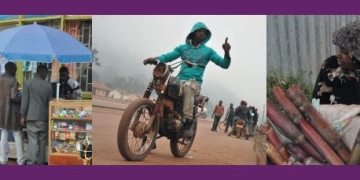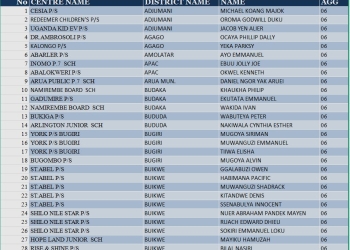
KAMPALA: A red flag has been raised on the ongoing construction of the Shs 770 billion 159-kilometer Masindi Kisanja-Tangi-Paraa-Buliisa road, being undertaken by Chinese firm China Communications Construction Company Ltd (CCCC), with serious issues emerging after the termination of the contract of the external consulting engineers.
In the fall-out, also captured in a briefing to President Yoweri Museveni over corruption in the ongoing project, the spotlight has been shone on a move by the contractors Chinese firm CCCC to adjust one of the pavement sections in package one of the road from 810mm to 550mm, a move that has been flagged dangerous.
Engineers familiar with the original design of the road have warned that the final surface if approved with the suggested adjustments, will not be able to withstand the pressure from the traffic expected on the road.
According to the briefing to President Museveni seen by this reporter, the move also means that the contractors are able to save about $40 million (approx. Shs 144 billion), but surprisingly, the supervising engineers at UNRA approved the contractor’s request for approval for this to amend the pavement structure, without amending the changes in cost.
Officials at the Uganda National Roads Authority (UNRA), who are the employers, Chinese contractor- CCCC, and the new supervising firm, PROME Consultants Ltd, are blamed for giving a blind eye to this anomaly after UNRA, surprisingly substituted the original supervising engineers from Kuwait-based, Abuljebain Engineering Consulting Office (AECO) to PROME Consultants Ltd, a local firm.
Both UNRA and the CCCC have been quoted by the Observer Newspaper of Wednesday, October 19, 2021, denying any wrongdoing.
Surprisingly, in the same Newspaper, CCCC officials are quoted as conceding that some sections of the road had failed, an issue that has been raised in a brief to President Museveni, seen by this writer.
“It’s true that we observed some minor cracks on the road, and the cracks are mainly at the edge of the shoulder. After careful study, we believe that the cracks are because of the differential settlement at the joint of the existing road and the new constructed road,” a CCCC official is quoted as saying.
“To mitigate this defect, we put some fiberglass geogrid before lay the Asphalt Concrete. Fiberglass geogrid is an expensive material but can effectively mitigate the defect, but in order to give a better road for Uganda, CCCC provide it without extra cost from UNRA” CCCC said.
On August 19, 2020, UNRA controversially terminated AECO’s contract as the project supervising engineers and replaced them with PROME Consultants Ltd.
It is understood that PROME had been subcontracted to provide manpower on the same project in November 2018 as one of the local contractors.
In the termination letter, URNA stated that AECO failed to mobilize staff, make monthly reports and refused to approve the contractor (CCCC)’s submissions and instructions in time, among others.
In a petition to President Museveni, however, AECO executive director Wail Khaireddin Abuljebain dismissed the UNRA’s claims, arguing that they terminated for “convenience” and not non-performance.
Mr. Abuljebain notes that the executive director of UNRA Allen Kagina visited the site several times and was always ‘very satisfied’ with their performance.
“On her last visit in 2020, she told our Resident Engineer Mr Aymman Khair that UNRA had no problem with AECO in this project of the Oil roads,” he stated in the petition to the President, adding;
“The irony lies in the fact that after termination of AECO, UNRA is currently finalizing the project using 99 percent of the staff members of AECO except for the Resident engineer who left for Sudan”.
Soon after the termination of the Kuwait based supervising engineers, UNRA approved the change in pavement structure, a matter that has raise eyebrows.
According to letters on the record, UNRA had before, stuck to implementing the original pavement design, which put thickness of the road at the standard (T8) ideal for heavy-load oil trucks.
In a letter, dated October 18, 2018, Engineer Alfred Ogik, URA’s director Roads and Bridges Development, then, rejected CCCC’s proposal (in a letter on August 16, 2018) to reduce the road overall material pavement depth from 810mm (T8) to 550mm (T6).
In his response to CCCC’s proposal, Eng. Ogik wrote:
“Please note that, according to Chapter 10 of the South African Pavement Engineering Manual, the recommended minimum pavement thickness for a category B Road is 800mm in order for the pavement strength to be sufficient to withstand the traffic-imposed stresses”.
He added:
“In view of the above, we would like to inform you that we are not in agreement with the proposed pavement structure. You are advised to ensure that the proposed pavement structure meets the minimum material depth of 800mm as recommended under the South African Pavement Manual.”
Eng. Ogik has since been replaced by Eng. Samuel Muhoozi, but the anomaly remains.
Eng. Ogik is now head of URNA’s Road Development.
Before Eng. Ogik’s rejection, there was an earlier warning against contractor (CCCC)’s proposals to alter the road’s material pavement structure original designs.
In a letter written on August 18, 2018, Christopher Manyindo, the then URNA’s head Roads Development, stated that CCCC’s reasons to alter the pavement structure were not convincing.
Eng. Manyindo argued that CCCC’s proposed pavement design was not ideal for Sub-Saharan conditions and could not withstand the projected heavy-load vehicles that will be using the road once completed.
“The traffic analysis conducted by the Contractor [CCCC] has resulted into a design traffic loading that is significantly lower than the traffic loading used in the preliminary pavement design,” adding;
“The submitted proposal for value engineering is on the basis of a traffic loading of 6.8 million equivalent standard axles that is significantly lower than the traffic loading of 34.84 million equivalent standard axles used in the preliminary pavement design,”.
He added:
“Since the assumptions for the traffic projections by the Contractor result in a traffic loading lower than the earlier projections it is advised that the Contractor adopts the Employer’s [UNRA] traffic projections.”
“Therefore, the purpose of writing is to inform you that in the absence of necessary justification, the reference pavement structure submitted as per Employer’s requirement in the Contract should be maintained,” Manyindo concluded.
However, in a turn of events, the UNRA later cleared CCCC to go ahead with T6 material pavement, which technically not only poses a big threat to future users of the road but also portents a financial loss to the taxpayers of Uganda.
There is also controversy on the two bridges, presumably constructed on Lot 7B, the 12-kilometre stretch between Sambiya and Murchison Falls.
“This is an uphill stretch with no swamps, no rivers so there’s no need to build bridges here yet the the contractor (CCCC) quoted in the Bill of Quantities (BOQ),” the brief to President Museveni reads.
And if, indeed, these non-existent bridges are approved, with each costed at $2million, UNRA will pay the contractor $4million for ghost bridges.
According to the briefing to the President, CCCC bought 12 vehicles (ten Pickups for field work and two Prados) for the project, with each quoted to have cost a whopping $900,000 in the bill of quantities.
In comparison, the market prices of new Toyota pickups (double or single cabin) range between $45,0000 and $80,0000.
About the road:
The Masindi (Kisanja)-Park Junction-Tangi-Paraa-Buliisa road is one of the multibillion oil transport infrastructure projects, which the government signed off since 2008, to facilitate oil production and development in Uganda Graben region. After securing a loan of Shs 770bn from the China Exim Bank, Chinese firm, CCCC, started constructing the 159-kilometre road in April, 2018.
According to the original contract projections, CCCC was expected to complete the road next month. However, there have been challenges such as delayed payments and the prolonged lockdown due to Covid-19 pandemic, which slowed down CCCC and the sub contracts’ works on the road.
Currently, officials put physical works progress at 77 percent and admit that UNRA is at risk of paying interest accumulated because of the aforesaid delays.
Once completed, the road crosses, which connects three districts (Masindi, Nwoya and Buliisa), is expected to bring about economic transformation for the local people due to improved access and businesses developing along the way.


















